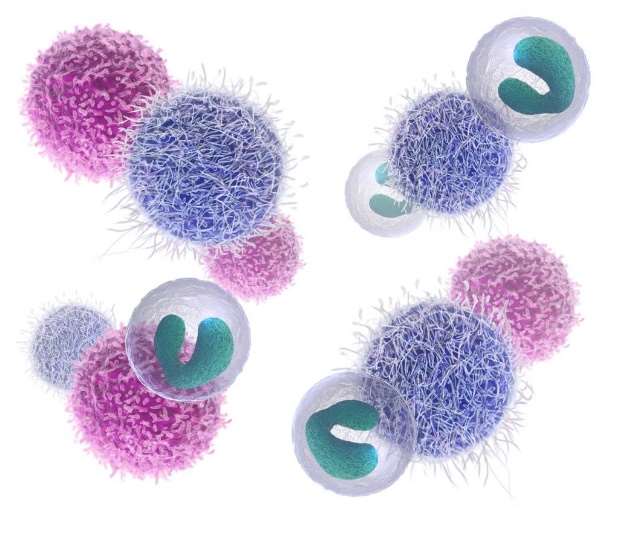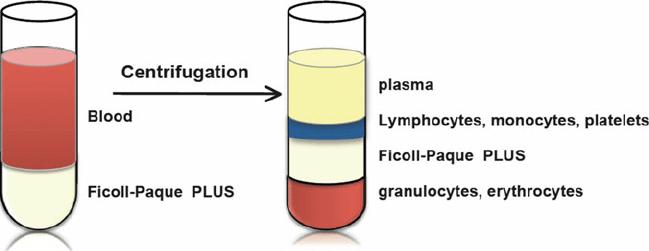What Are PBMCs?

Peripheral blood mononuclear cell (PBMC) refers to cells in the peripheral blood that have a single nucleus.
PBMCs include lymphocytes (T cells, B cells and NK cells), monocytes and DC cells. In humans, the proportion of these cell populations varies among individuals. Typically PBMCs contain 70 - 90% lymphocytes, 10 - 30% monocytes and only 1 - 2% DC cells. Of the lymphocytes, CD3+ T cells account for 70 - 85% (45 - 70% in PBMCs), B cells for 5 - 20% (up to 15% in PBMCs) and NK cells for 5 - 20% (up to 15%).
Origin of PBMC in Humans
Peripheral blood mononuclear cells are derived from haematopoietic stem cells (HSCs) in the bone marrow. HSCs produce all the blood cells in the immune system through the haematopoietic process. HSCs produce myeloid cells (monocytes, macrophages, granulocytes, megakaryocytes, dendritic cells, red blood cells) and lymphocytes (T cells, B cells, NK cells) during haematopoiesis.
How is PBMC Separation?
PBMC is mainly separated from blood using density gradient centrifugation. The principle is to separate different substances according to their density.
PBMCs include lymphocytes and monocytes, among others, and their characteristics such as volume, morphology and density differ from other cells. Erythrocytes and granulocytes are denser at approximately 1.090 g/mL; lymphocytes and monocytes are denser at 1.075 g/mL to 1.090 g/mL; and platelets are 1.030 g/mL to 1.035 g/mL. When a solution with a density between 1.075g/mL and 1.092g/mL and near isotonicity (stratification solution) is used for density gradient centrifugation, cells of a certain density are distributed according to the corresponding density gradient, thus separating the various blood cells.
 Isolation of PBMCs (Bharadwaj et al., 2012)
Isolation of PBMCs (Bharadwaj et al., 2012)
PBMC are primary cells, which are different from cell lines, and are cultured in vitro and need to be stimulated with inducers in order to proliferate. The proliferation process also requires the addition of different cytokines, such as IL-2 and IL-4. For fresh PBMC or resuscitated frozen PBMC, the cell density is usually adjusted to 2x10⁶/ml and activators, cytokines and drugs are added during the culture process.
PBMC contain a variety of subpopulations of cells and for experiments investigating a specific subpopulation of cells, they need to be sorted out from PBMC. Immunomagnetic bead sorting can be used to obtain subpopulations of cells.
Cytokines in PBMC
In order to maintain the physiological balance of the body, resist the attack of pathogenic microorganisms and prevent tumor development, many cells of the body, especially immune cells, synthesis and secrete many kinds of peptide-like factors in minute amounts, which are called cytokines.
Cytokines include lymphokines produced by lymphocytes, mononuclear factors produced by monocytes and various growth factors. They transmit information between cells, regulate their physiological processes, enhance the immunity of the body and may also cause pathological processes such as fever, inflammation and shock under abnormal conditions.
Phenotypic and functional studies of PBMCs can contribute to the study of the human immune system. So how to analyze the cytokines secreted by PBMC cells?
Luminex technology is based on encoded microspheres and is capable of detecting multiple cytokines in PBMC samples simultaneously. With only 25-50ul of sample, up to 40 protein markers can be detected simultaneously with high sensitivity, a wide dynamic detection range and cost effectiveness.
Reference:
- Bharadwaj, M., Mifsud, N. A., & McCluskey, J. (2012). Detection and characterisation of alloreactive T cells. In Immunogenetics (pp. 309-337). Humana Press, Totowa, NJ.



